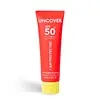What's inside
What's inside
 Key Ingredients
Key Ingredients

 Benefits
Benefits

 Concerns
Concerns

 Ingredients Side-by-side
Ingredients Side-by-side

Water
Skin ConditioningButylene Glycol
HumectantAlcohol
AntimicrobialButyloctyl Salicylate
Skin ConditioningDiethylamino Hydroxybenzoyl Hexyl Benzoate
UV FilterBis-Ethylhexyloxyphenol Methoxyphenyl Triazine
Skin ConditioningDibutyl Adipate
EmollientEthylhexyl Triazone
UV AbsorberHexyl Laurate
EmollientPolymethylsilsesquioxane
Bis-PEG/PPG-16/16 PEG/PPG-16/16 Dimethicone
EmollientCaprylyl Methicone
Skin ConditioningSodium Acrylates Crosspolymer-2
AbsorbentPolysilicone-15
UV FilterIsoamyl P-Methoxycinnamate
UV Absorber1,2-Hexanediol
Skin ConditioningPentylene Glycol
Skin ConditioningPolysorbate 60
EmulsifyingSodium Acrylate/Sodium Acryloyldimethyl Taurate Copolymer
Emulsion StabilisingPolyisobutene
Chlorella Vulgaris Extract
Skin ConditioningGlucose
HumectantCaprylic/Capric Triglyceride
MaskingSodium Polyacryloyldimethyl Taurate
Emulsion StabilisingHydroxyacetophenone
AntioxidantPanthenol
Skin ConditioningPolyacrylate Crosspolymer-6
Emulsion StabilisingFructooligosaccharides
HumectantFructose
HumectantAloe Barbadensis Leaf Extract
EmollientCaprylyl/Capryl Glucoside
CleansingSorbitan Oleate
EmulsifyingDisodium EDTA
T-Butyl Alcohol
PerfumingEthylhexylglycerin
Skin ConditioningTocopherol
AntioxidantPentaerythrityl Tetra-Di-T-Butyl Hydroxyhydrocinnamate
AntioxidantHyaluronic Acid
HumectantCitric Acid
BufferingPotassium Sorbate
PreservativeSodium Benzoate
MaskingAscorbic Acid
AntioxidantHydrolyzed Hyaluronic Acid
HumectantSodium Hyaluronate
HumectantOryza Sativa Bran
AbrasiveWater, Butylene Glycol, Alcohol, Butyloctyl Salicylate, Diethylamino Hydroxybenzoyl Hexyl Benzoate, Bis-Ethylhexyloxyphenol Methoxyphenyl Triazine, Dibutyl Adipate, Ethylhexyl Triazone, Hexyl Laurate, Polymethylsilsesquioxane, Bis-PEG/PPG-16/16 PEG/PPG-16/16 Dimethicone, Caprylyl Methicone, Sodium Acrylates Crosspolymer-2, Polysilicone-15, Isoamyl P-Methoxycinnamate, 1,2-Hexanediol, Pentylene Glycol, Polysorbate 60, Sodium Acrylate/Sodium Acryloyldimethyl Taurate Copolymer, Polyisobutene, Chlorella Vulgaris Extract, Glucose, Caprylic/Capric Triglyceride, Sodium Polyacryloyldimethyl Taurate, Hydroxyacetophenone, Panthenol, Polyacrylate Crosspolymer-6, Fructooligosaccharides, Fructose, Aloe Barbadensis Leaf Extract, Caprylyl/Capryl Glucoside, Sorbitan Oleate, Disodium EDTA, T-Butyl Alcohol, Ethylhexylglycerin, Tocopherol, Pentaerythrityl Tetra-Di-T-Butyl Hydroxyhydrocinnamate, Hyaluronic Acid, Citric Acid, Potassium Sorbate, Sodium Benzoate, Ascorbic Acid, Hydrolyzed Hyaluronic Acid, Sodium Hyaluronate, Oryza Sativa Bran
Water
Skin ConditioningEthylhexyl Methoxycinnamate
UV AbsorberGlycerin
HumectantPropylene Glycol
HumectantCyclopentasiloxane
EmollientPhenylbenzimidazole Sulfonic Acid
UV AbsorberBis-Ethylhexyloxyphenol Methoxyphenyl Triazine
Skin ConditioningDicaprylyl Carbonate
EmollientIsoamyl P-Methoxycinnamate
UV AbsorberPotassium Cetyl Phosphate
EmulsifyingAlcohol
AntimicrobialDimethicone
EmollientButylene Glycol
HumectantGlyceryl Stearate
EmollientTitanium Dioxide
Cosmetic ColorantC14-22 Alcohols
Emulsion StabilisingPolymethyl Methacrylate
Cetearyl Alcohol
EmollientPEG-100 Stearate
Triethanolamine
BufferingSilica
AbrasiveSodium Hydroxide
BufferingDimethicone/Vinyl Dimethicone Crosspolymer
Skin ConditioningC12-20 Alkyl Glucoside
EmulsifyingAluminum Hydroxide
EmollientStearic Acid
CleansingParfum
MaskingCaprylyl Glycol
EmollientPhenoxyethanol
PreservativeAcrylates/C10-30 Alkyl Acrylate Crosspolymer
Emulsion StabilisingAloe Arborescens Leaf Extract
MoisturisingDipotassium Glycyrrhizate
HumectantCarbomer
Emulsion StabilisingXanthan Gum
EmulsifyingLimonene
PerfumingTocopheryl Acetate
AntioxidantDisodium EDTA
Hexyl Cinnamal
PerfumingLinalool
PerfumingBenzyl Salicylate
PerfumingGeraniol
PerfumingBenzyl Alcohol
PerfumingCitronellol
PerfumingBenzyl Benzoate
AntimicrobialCitral
PerfumingWater, Ethylhexyl Methoxycinnamate, Glycerin, Propylene Glycol, Cyclopentasiloxane, Phenylbenzimidazole Sulfonic Acid, Bis-Ethylhexyloxyphenol Methoxyphenyl Triazine, Dicaprylyl Carbonate, Isoamyl P-Methoxycinnamate, Potassium Cetyl Phosphate, Alcohol, Dimethicone, Butylene Glycol, Glyceryl Stearate, Titanium Dioxide, C14-22 Alcohols, Polymethyl Methacrylate, Cetearyl Alcohol, PEG-100 Stearate, Triethanolamine, Silica, Sodium Hydroxide, Dimethicone/Vinyl Dimethicone Crosspolymer, C12-20 Alkyl Glucoside, Aluminum Hydroxide, Stearic Acid, Parfum, Caprylyl Glycol, Phenoxyethanol, Acrylates/C10-30 Alkyl Acrylate Crosspolymer, Aloe Arborescens Leaf Extract, Dipotassium Glycyrrhizate, Carbomer, Xanthan Gum, Limonene, Tocopheryl Acetate, Disodium EDTA, Hexyl Cinnamal, Linalool, Benzyl Salicylate, Geraniol, Benzyl Alcohol, Citronellol, Benzyl Benzoate, Citral
 Reviews
Reviews

Ingredients Explained
These ingredients are found in both products.
Ingredients higher up in an ingredient list are typically present in a larger amount.
Alcohol comes in many different forms. Different types of alcohol will have different effects on skin. This ingredient is usually an astringent alcohol.
These alcohols are drying on the skin. They may strip away your skin's natural oils and even damage your skin barrier. Astringent alcohols may also irritate skin.
Other types of astringent alcohols include:
According to the National Rosacea Society based in the US, you should be mindful of products with these alcohols in the top half of ingredients.
Any type of sanitizing product will have high amounts of alcohol to help kill bacteria and viruses.
Fatty alcohols come from plant oils such as coconut oil. These can help hydrate the skin and are non-irritating. Some fatty alcohols include cetyl and stearyl alcohol.
Learn more about AlcoholYou might know this ingredient as Tinosorb S or Bemotrizinol. It is a UV filter that covers both UVA and UVB rays.
This ingredient has two peak UV absorption peaks ( 310 and 340 nm) and is able to absorb both UV-A and UV-B rays. This ingredient works by preventing UV rays from reaching and damaging your skin.
On top of that - it is highly photostable and helps prevent the photodegration of other sunscreen ingredients such as avobenzone.
Tinosorb S is allowed in the EU, Australia, and Asia. It is close to being approved by the FDA and we'll hopefully get this ingredient in the U.S. by late 2025.
Fun fact: Tinosorb S is the most effective UV absorber at maximum concentration (measured by SPF) permitted in the EU.
This ingredient is oil-soluble, so your oil-cleansers will take this right off at night.
Learn more about Bis-Ethylhexyloxyphenol Methoxyphenyl TriazineButylene Glycol (or BG) is used within cosmetic products for a few different reasons:
Overall, Butylene Glycol is a safe and well-rounded ingredient that works well with other ingredients.
Though this ingredient works well with most skin types, some people with sensitive skin may experience a reaction such as allergic rashes, closed comedones, or itchiness.
Learn more about Butylene GlycolDisodium EDTA plays a role in making products more stable by aiding other preservatives.
It is a chelating agent, meaning it neutralizes metal ions that may be found in a product.
Disodium EDTA is a salt of edetic acid and is found to be safe in cosmetic ingredients.
Learn more about Disodium EDTAAmiloxate is a chemical sunscreen absorber. It mainly protects against UV-B rays (290-320 nm) but offers a bit of UV-A protection (320-340 nm).
This ingredient is available in the EU (up to 10%) and Asia. However, it has not yet been approved in the US or Canada.
It is created from isoamyl alcohol and methoxycinnamic acid.
Studies show the structural similarities between this ingredient and cinnamic acid give it anti-inflammatory and antioxidant properties. In fact, it is believed amiloxate works by scavenging free-radical molecules from UV.
One animal study found this ingredient was not absorbed or able to penetrate through skin.
Learn more about Isoamyl P-MethoxycinnamateWater. It's the most common cosmetic ingredient of all. You'll usually see it at the top of ingredient lists, meaning that it makes up the largest part of the product.
So why is it so popular? Water most often acts as a solvent - this means that it helps dissolve other ingredients into the formulation.
You'll also recognize water as that liquid we all need to stay alive. If you see this, drink a glass of water. Stay hydrated!
Learn more about Water